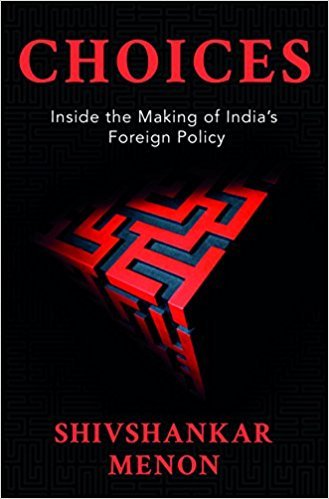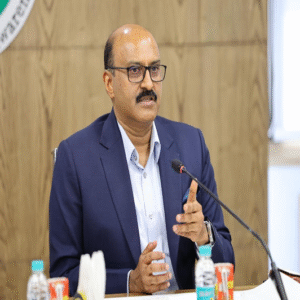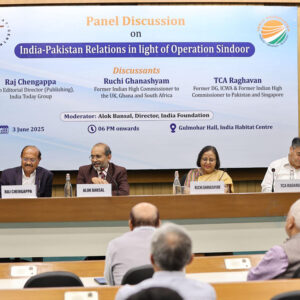“Strategy consists of making the most of available means to achieve one’s goals. India’s goal is to transform India”
– Shiv Shankar Menon, Choices
India’s former National Security Advisor (NSA), Shiv Shankar Menon’s book “Choices: Inside the making of India’s Foreign policy” is a good read to understand the post-cold war decision making in Indian foreign policy. Mr. Menon describes the insider’s account of five crucial scenarios India has faced during his long career in government. The border peace and tranquility agreement with China, the negotiation of the nuclear agreement with the USA, India’s response to the 26/11 Mumbai attacks by Pakistani terrorists, the final stages of Sri Lankan civil war and the evolution of India’s nuclear doctrine -‘No First Use policy’. In each case, Menon starts with the context, the choices that Delhi had to make and the lessons from these decisions. He also clearly explains the intricacies of getting things done within the political and institutional constraints that he faced which remind us about the need for reforms in India’s governance structures. Menon’s clear articulation of complex topics and command over the details makes each account a very exciting and informative read for anyone interested in India’s foreign policy.
He starts with the 1993 Border Peace and Tranquility Agreement with China – the first ever boundary related agreement between modern states of India and China in which he played a crucial role. He dwells deeper into the historical aspects of India-China ’border’, the 1962 war, Chinese strategy regarding India and Pakistan and its greater goal of becoming a preeminent global power, the intricate details of the negotiations and the calculations which went into the making of the agreement and finally the lessons learned from the agreement. Menon is of full praise to former Prime Minister P.V. Narasimha Rao for leading public opinion and building consensus while bringing along his political opponents for the fruition of the agreement.
The second chapter deals with the Civil Nuclear initiative between India and USA which was started by the first UPA government and which became the pillar of trust and cooperation between India and USA. He covers the entire negotiations which happened between India and USA as well as in international agencies like IAEA, Nuclear Suppliers Group as well as in the US Congress and Indian Parliament. He concludes the chapter by explaining what the civil nuclear initiative means for the larger geopolitics in the 21st century. In his own words the Indo-US nuclear agreement was always much more than a dollar and cents calculation or the import of reactors, or cheap renewable energy for India’s future. It was about much bigger things – like the strategic need to stand up together to balance the rise of China and chart a new century of cooperation between two countries whose strategic objectives converge almost on every aspect in Asia.
The third chapter deals with the question of why India didn’t use overt force against terrorist groups based in Pakistan after the 26/11 attacks in Mumbai in 2008. After dissecting the decision to not militarily respond to the 26/11 attack on Mumbai, Menon argues Prime Minister Manmohan Singh made the right decision not to respond. But at the same time, he believes that future Indian governments will not be so restrained as the context and personalities heading the country has changed.
India’s involvement in the Sri Lankan civil war is one of its most traumatic overseas adventure till date. It led to thousands of Indian deaths including that of the former Prime Minister Rajiv Gandhi. Chapter four deals with India’s experience in Sri Lanka during the Sri Lankan civil war and how choices were made by New Delhi by giving the detailed overview of the different interests and strategic calculations which went into each decision.
Chapter five deals with India’s nuclear doctrine of ‘No First Use’ and he explains clearly why this is the best policy for India which allows India to focus on domestic transformation and economic growth without wasting time and effort on a nuclear arms race. But at the same time and gaining a strategic equivalence by indulging in deterrence strategy.
Menon concludes the book with a valuable reflection on India’s international destiny, its strategic culture and the kind of great power it might become. He offers insights into the emerging constraints on statecraft in this century and the need for strong institutional mechanism to solve issues in the foreign and security policymaking in the coming decades. Menon doesn’t answer directly to the question of whether India has a strategic culture but affirms that there is an Indian way of foreign policy which is “marked by a combination of boldness in conception and caution in implementation, by the dominant and determining role of the Prime Minister”. Menon warns Delhi against embracing ambitions of becoming a traditional great power and forgetting the priority of domestic transformation and reminds of Germany and Japan as examples of rising powers that prematurely thought that their time had come for global domination. Menon ends the book with the discussion on why India needs to be a great power and how it should be a ‘different power’ which uses its power first for domestic transformation of India itself.
Choices should be considered as one of the rare good books on the inside deliberations and thought processes which go into making the Indian security and foreign policy decisions. It is a must-read for anyone who would like to know how and why India has made certain ‘choices’ in its relations with the outside world and how it is trying to be a great power with a difference.
Author: Shivshankar Menon
Publisher :Penguin Random House India, 2016, pp 224
Price: Rs.599/-
Book Review by: Jerin Jose
(Jerin Jose is a Young India fellow, from the 2016-17 batch at Ashoka University.
He can be reached at jerinjose1906@gmail.com)




